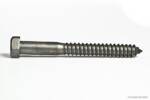How do I determine the shear capacity and strength of lag screws?

Unfortunately, we have no specific data to answer this question. First, “standard” lag bolts that are readily available in the marketplace are ungraded, meaning they are not manufactured to any ASTM specification and have no verifiable mechanical requirements. Therefore, it is impossible to determine the strength characteristics of a lag screw unless they are custom manufactured or the specific lot of bolts is tested. Second, the forces that are acting on these lag screws will affect their ability to hold the structure in place. The shear strength of a fastener is approximately 60% of its tensile strength, but this is only an approximation and unless you have graded lag screws, there is no way to determine shear or tensile strengths. Additionally, the type of wood, grain structure, etc. will determine the ability for a lag screw to withstand the forces that are acting against it. Finally, we have no engineers on staff and due to liability issues; we are not in a position to answer these types of questions. We would recommend contacting a structural engineer.
The American Wood Council has more information regarding wood construction and specific lag bolt recommendations. They also have an extensive wood connection calculator.


Excellent Text book, “Design of Wood Structures” , Author: Donald E. Breyer, Publisher: McGraw Hill.
Also, Available online: United States Department of Agriculture, Technical Bulletin No. 597 Published January 1938, ” Lag-Screw Joints: Their Behavior and Design”, Authored J.A. Newlin, principal engineer, and J.M. Gahagan, Asst. engineer, Forest Products Laboratory, Div. Research, Forest Service.
George M. Slaughter, Architect, LEED AP
Shear value of a 3/8″ lag screw.
@Bob- Lag screws are not tested for shear, so we do not have any exact values. However, shear strength is typically about 60% of tensile, so we can get you a ballpark. Assuming your lag screw is A307A, as most are, the shear value in the unthreaded shank should be about 3900lbs and the shear value in the threaded portion should be about 2200lbs.
What are the values to be considered in desogn for 3/8″ lag bolts.
I need following values:
Allowable Shear
Allowable Tension
Thickness of wood block varies
Connecting metal thickness varies
@Alex-
Apologies, but we do not have that information. The AWC or CWC might have some wood design information.
Please let me know what is the capacity of a 22mm by 15mm long lagbolt is in SPF?
@Laszlo- Apologies, but we are unable to provide that information.
Dane,
Does this mean that this type of lag screw can withstand thousands of shear force? Compare to what’s in AWC, it’s only in hundreds.
@Czar- The amount of shear that a lag screw can withstand will depend on the diameter of the fastener. Smaller screws will be in the hundreds, but larger screws can easily withstand thousands of pounds.
I’m reading that “structural screws” (apparently some are available with hex heads as versus some sort of traditional screw head) are stronger than lag bolts (also known as lag screws). From what I’ve read, structural screws are made of a stronger, better steel.
@Gary- Most bolts or screws can be made in several different grades, some of which would be considered structural. Typically off the shelf lag bolts (or lag screws) are made from ungraded, low carbon steel. Specials could be made out of structural grades.
The 3/8 and 1/2 inch lag bolts both sheared in half under twisting force from a ratchet. (not much force either) Is this an indication of a faulty bolt? Could I also assume these bolts have a low shear strength? I wouldn’t feel comfortable using them to support, say, a rim joist for a deck.
@Steve- We couldn’t rule out a faulty bolt, however in our experience it does not take a lot of force to torsionally shear a small lag bolt. Lag bolts are typically low carbon steel and not all that strong, but they should still be able to support several hundred pounds in shear. That said, if you are concerned, consulting a structural engineer might be a good course of action.
Per IBC and other model codes, refer to American Forest & Paper Association (American Wood Council) National Design Standard (NDS) for wood structures, Chapter 11, for information on code-recognized design values for lag screws.
Which is stronger and a better fastner, 3/8×4 lag bolts or Simpson Strong Drive SDWS structural wood screw 4″ long.
@Gene Eichel – Lag screws are typically made per SAE J429 grade 1, which is a low carbon steel with a minimum tensile of 60ksi and a minimum yield of 36ksi. Simpson SDWS screws, according to their website are made from heat treated carbon steel. It does not list any specifics in regards to their mechanical properties, but any heat treated carbon steel will be stronger than SAE J429 grade 1. So from a simple material standpoint, the Simpson screws will be stronger. However, the Simpson screws appear to max out at 0.220″ diameter, whereas the lag bolt you question is 3/8″. Without specifics about the mechanicals for the Simpson screws, I cannot give you a functional comparison. You may be able to contact an engineer with Simpson and they may be able to get you more specific information.
Hi there Greg,
Great answer. Luckily I seen this post. And now I know what should I buy when buying a screw.